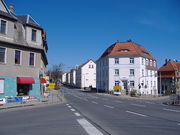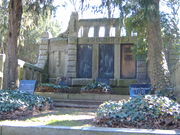Ruppertsgrün (Fraureuth)
|
Ruppertsgrün
Community Fraureuth
Coordinates: 50 ° 41 ′ 50 ″ N , 12 ° 22 ′ 1 ″ E
|
||
|---|---|---|
| Height : | 306 m above sea level NN | |
| Residents : | 1600 | |
| Incorporation : | January 1, 1998 | |
| Postal code : | 08427 | |
| Area code : | 03761 | |
|
Location of Ruppertsgrün in Saxony |
||
Ruppertsgrün is a place in the large community of Fraureuth in the district of Zwickau , Free State of Saxony and has almost 1,600 inhabitants.
geography
location
Ruppertsgrün is located in the eastern municipality of Fraureuth. The development merges seamlessly into the Fraureuth part of the municipality to the west. The Lohbach, a tributary of the Pleiße, flows through the village . Ruppertsgrün is located in the Upper Pleißeland natural area . In the northeastern town hall of Ruppertsgrün is the Bogendreieck Werdau in which the Dresden-Werdau railway in the Leipzig-Hof railway opens.
Neighboring places
| Leubnitz | ||
| Fraureuth |

|
Steinpleis |
| Beiersdorf | Gospersgrün |
history
12th to 18th centuries
The name Ruppertsgrün is derived from its founder Ruppert. The name Rupert is Old High German and means something like "the one who shines through his fame" ( Ruprecht = old German variant through which Rupert or Ruppert later emerged).
According to old records, the place was founded by settlers from Bohemia and Franconia between 1150 and 1190 as part of the second stage of eastern colonization . Ruppertsgrün was a small farming settlement. The first documentary mention of the place as Ruprechczgrune dates back to May 11, 1398. In it, the gentlemen of Schönfels and Hans von Schoninvels (see also Schönfels Castle ) are named as the owners of the manor in Ruppertsgrün. These had a significant influence on the development of the place. Through them the village was ruled for several centuries. Many peasants lived in serfdom to the rule of Schönfels and had to do their labor in the period of feudalism . It was not until 1865 that the place's dependency on the rule of Schönfels ended. The family grave of the von Schönfels family can still be found in the local cemetery of Ruppertsgrün. In 1505 the castle chapel was inaugurated under Siegmund von Schönfels and in the years 1513 to 1515 the von Schönfels family donated a church with a church school to the place (opposite the present church). First, monks from Frankenhausen held the service . In 1515 Ruppertsgrün received the right of patronage over the church and school. At that time Ruppertsgrün belonged to the Electorate of Saxony . The inhabitants of the village earned their living with agriculture , arable farming but also with house spinning and weaving as well as with work in a brewery and a mill . In 1547 Emperor Karl V marched from Plauen through Ruppertsgrün to Werdau against Elector Friedrich of Saxony . In a fire on May 24, 1724, all of the farm buildings of the Ruppertsgrün manor were destroyed. This was rebuilt later and in 1796 a brewery and in 1852 a brewery cellar were built in Ruppertsgrün.
19th century to the present
At the time of the Wars of Liberation, Ruppertsgrün suffered from the billeting of Imperial Austrian and Imperial Russian troops between 1812 and 1814 . In 1834 the construction of a road began from Werdau through the corridors from Ruppertsgrün to Reichenbach and in 1844 the Ruppertsgrüner arched triangle was created in the course of the construction of the Saxon-Bavarian railway line . With advancing industrialization , the appearance of Ruppertsgrün also changed, especially due to the enormous development of the textile industry in this region of Saxony. As early as 1845, the industrial community of Ruppertsgrün had around 1350 inhabitants. In 1855 and 1856 Eduard Heinrich von Schönfels bought two spinning mills from the manufacturer Hofmann in Ruppertsgrün, equipped them with a steam engine and leased them.
The manorial rule over Ruppertsgrün was with the local manor Ruppertsgrün until the middle of the 19th century . Until 1856, Ruppertsgrün belonged to the Electoral Saxon or Royal Saxon Office of Zwickau in the Ore Mountains District . In 1856 Ruppertsgrün was assigned to the Werdau court office and in 1875 it was incorporated into the Zwickau administration .
In 1881 a new school building was built. It served as a village school until it was closed in 2009, including as a polytechnic high school (POS Arkadi Gaidar ) and most recently as a primary school . From the year 1887 to 1908 several large textile companies were established in the village, e.g. E.g. the Vigogne and carded yarn spinning mill Ferdinand Puchert , later run as a state-owned company VEB Zweizylinderspinnerei Werdau (ZWEIGA) . The unused building complex of the factory was finally demolished in 2010. There has been a volunteer fire brigade in the village since 1899 and in 1909 the construction of the Goldene Sonne inn , which later also served as a community center and today includes a butcher shop with a restaurant, a hostel (with 5 rooms), 2 event halls and a bowling alley .
In 1918 the era of the Kingdom of Saxony ended . In 1920 Ruppertsgrün was assigned to the Werdau administration . Due to the dissolution of the administrative district in 1933, the place came back to the Zwickau district administration, which from 1939 was called the Zwickau district. The First World War and also the Second World War brought victims to the place. The war memorial for the fallen of the First World War still marks the townscape today. On January 26 and 27, 1945, the bodies of four concentration camp inmates were found on Ruppertsgrüner Flur . These come from the death marches of the Auschwitz concentration camp (including the satellite camp), which were "cleared" shortly before the liberation . On January 26, 1945 a prisoner was shot dead by an SS man while he was fleeing. Three other dead were found on the Leipzig – Hof railway line on January 27, 1945. They were buried in the dark and without causing a stir in the Ruppertsgrün cemetery.
In April 1945 the place was liberated by the US Army . However, this had to be handed over to the Soviet occupation zone after the Potsdam Conference . The US Army withdrew its armed forces from West Saxony to Bavaria . In September 1945 the land reform began in Germany , the textile factory and the manor became public property . Since 1949 the place belonged to the GDR . As a result of the second district reform in the GDR , the municipality of Ruppertsgrün came to the Werdau district in the Chemnitz district in 1952 (renamed the Karl-Marx-Stadt district in 1953 ). The old manor now served as a residential building and part of the LPG ( agricultural production cooperative ). In the 1950s, the industrial estate was built in the direction of Steinpleis, new residential buildings in the GDR, which were mainly inhabited by workers from the VEB rolling bearing factory in Fraureuth and the LPG.
The German reunification in 1990 brought further major construction work, Ruppertsgrün now belonged to the Saxon district of Werdau and the construction of a new town center and the new buildings at Am Park began . On January 1, 1994, Beiersdorf and Gospersgrün were incorporated. In the same year, the municipality of Ruppertsgrün became part of the newly founded district of Zwickauer Land , which was added to the district of Zwickau in 2008. On January 1, 1998, Ruppertsgrün lost its independence and was merged with Fraureuth to form the large community of Fraureuth.
Impressions from Ruppertsgrün
Golden Sun Inn
War memorial for the fallen soldiers of the First World War
Memorials

- War memorial for the Franco-German War 1870/71 and for the victims of the First World War 1914–1918
- Grave site of the von Schönfels family (noble family) and the Puchert family of manufacturers in the local cemetery
- Grave site for four concentration camp prisoners of the death march from 26./27. January 1945 from Auschwitz
literature
- The district of Werdau , interesting facts from the past and present, ISBN 3-89264-886-7 .
- Communications from the Royal Saxon Association for Research and Conservation of Patriotic Historical and Art Monuments , Issue 17, Dresden 1867.
- Richard Steche : Ruppertsgrün. In: Descriptive representation of the older architectural and art monuments of the Kingdom of Saxony. 12. Issue: Zwickau Official Authority . CC Meinhold, Dresden 1889, p. 52.
Web links
- Ruppertsgrün in the Digital Historical Directory of Saxony
- District Ruppertsgrün on the Fraureuth homepage
Individual evidence
- ↑ Forms of place names etc. in digit. Histor. Place directory v. Saxony .
- ↑ Website of the Fraureuth community - history. Retrieved August 10, 2009 .
- ↑ The Ruppertsgrün manor at www.sachsens-schlösser.de
- ^ Karlheinz Blaschke , Uwe Ulrich Jäschke : Kursächsischer Ämteratlas. Leipzig 2009, ISBN 978-3-937386-14-0 ; P. 64 f.
- ↑ The Zwickau administrative authority in the municipal register 1900
- ↑ Ev.-luth. Ruppertsgrün parish - history. Retrieved August 10, 2009 .
- ↑ Fa. Ferdinand Puchert / VEB Zweizylinderspinnerei Werdau in the State Archives in Chemnitz ( Memento of the original from September 3, 2009 in the Internet Archive ) Info: The archive link was automatically inserted and not yet checked. Please check the original and archive link according to the instructions and then remove this notice. .
- ↑ http://www.mueller-landfleischerei.de/uberuns.html
- ↑ Jens Müller: One name is now known. In: Free Press. June 19, 2013, archived from the original on November 5, 2013 ; Retrieved July 5, 2013 .
- ↑ a b State Statistical Office of the Free State of Saxony: Area changes











